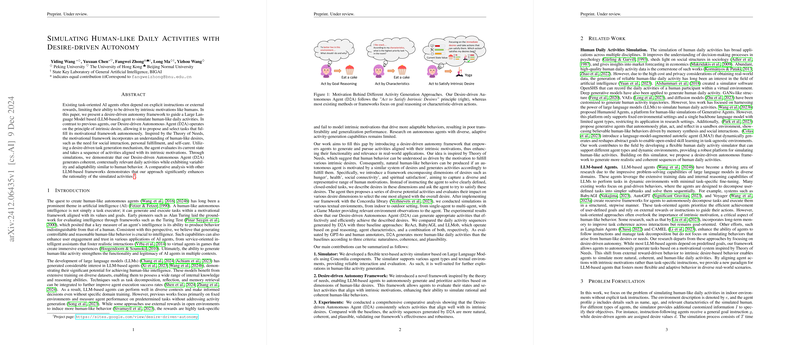Desire-Driven Autonomy for Human-Like Activity Simulation
The paper "Simulating Human-Like Daily Activities with Desire-Driven Autonomy" presents a novel methodology focusing on the simulation of human-like behaviors in AI systems, specifically through the mechanism of intrinsic desire-driven action selection. This work departs from traditional task-oriented AI, which often relies on explicit instructions or predefined goal-based frameworks. Instead, it incorporates intrinsic motivational structures inspired by human needs, an approach that offers AI agents the capacity to autonomously generate and prioritize tasks akin to human behaviors, emphasizing adaptability and variability.
Core Contributions
The paper introduces an innovative framework, the Desire-driven Autonomy (D2A), which leverages the intrinsic desire models derived from the Theory of Needs. Notable contributions include:
- Simulator Development: An advanced text-based activity simulator utilizing components of the Concordia library, facilitating interaction within varied textual environments. This simulator supports the dynamic interaction of multiple agent types, providing a robust environment for generating human-like activity sequences.
- Desire-driven Autonomy Framework: A motivational model based on intrinsic human desires, allowing agents to evaluate activities that align with internal needs such as social connectivity, spiritual satisfaction, and self-care, driving more coherent and human-like behaviors.
- Empirical Validation: Comprehensive experimental simulations show that D2A can produce activity sequences more coherent, natural, and plausible than its counterparts like ReAct, BabyAGI, and LLMob. This is validated through comparative analysis leveraging both machine and human evaluations.
Theoretical Implications
The paper provides significant theoretical advancements in simulating human-like intelligence through AI agents. By modeling desires dynamically and allowing agents to intermittently reassess and readjust their actions based on current desires, the framework offers a paradigm that closely mimics the natural adjustive processes in human decision-making. Such an approach fosters a deeper understanding of AI behavior modeling, moving beyond fixed task accomplishments to more fluid, adaptable functions that may increase user engagement and trust across applications from assistive technologies to immersive virtual environments.
Numerical Results and Insights
The experiments utilized varied environmental scenarios to test and validate the D2A's performance. Notably, the D2A consistently exhibited higher scores in human-likeness evaluations compared to baseline agents, as measured by both GPT-4o and human annotators. The simulations revealed that D2A's intrinsic motivation model led to more diverse action selection, effectively reducing dissatisfaction in desire dimensions more closely aligned with human self-reported activities. These results underline the framework's robustness in offering plausible simulation of human-like activities even when the environment settings are dynamic or randomized.
Practical Implications and Future Directions
In practical terms, the Desire-driven Autonomous framework can play a pivotal role in enhancing AI roles in virtual assistants, robotic companions, and simulation environments that benefit from human-like responsiveness and adaptability. This work also opens avenues for future research into the integration of deeper psychological and cognitive models to further refine AI behavior simulations.
Future research may expand the capability of D2A by incorporating real-time adaptive planning and decision-making modules that are responsive to highly dynamic settings. Additionally, exploring the integration of more sophisticated models of emotional and psychological behavior with the current intrinsic desire framework could yield even more realistic and adaptable AI agents.
Overall, by focusing on intrinsic motivation systems akin to human psychological frameworks, the approach outlined in this research enables a more nuanced simulation of intelligent behaviors, paving the way towards more engaging and effective AI systems.
